- JAPANESE
- LANGUAGE
X
 THAT IS GOOD
THAT IS GOOD
Hello, this is Kobayashi. In my last article (https://thatisgood.jp/en/taketokobayashi004/), I talked about how the eight million kamigami that had fallen out of the belief system were incorporated into folk beliefs and became yokai as time went by. My view is that the origin of the modern Japanese subculture lies in animism, which originated in the Jomon period. The existence of these storytellers is essential for the ancient kamigami and spirits to continue to flow through the undercurrent of Japanese culture and to survive to the present day changing their forms. Speaking of modern yokai storytellers, we cannot talk about them without mentioning the late Shigeru Mizuki, the creator of “Gegege no Kitaro (Spooky Kitarou)”. But first, I would like to go back in time a little.
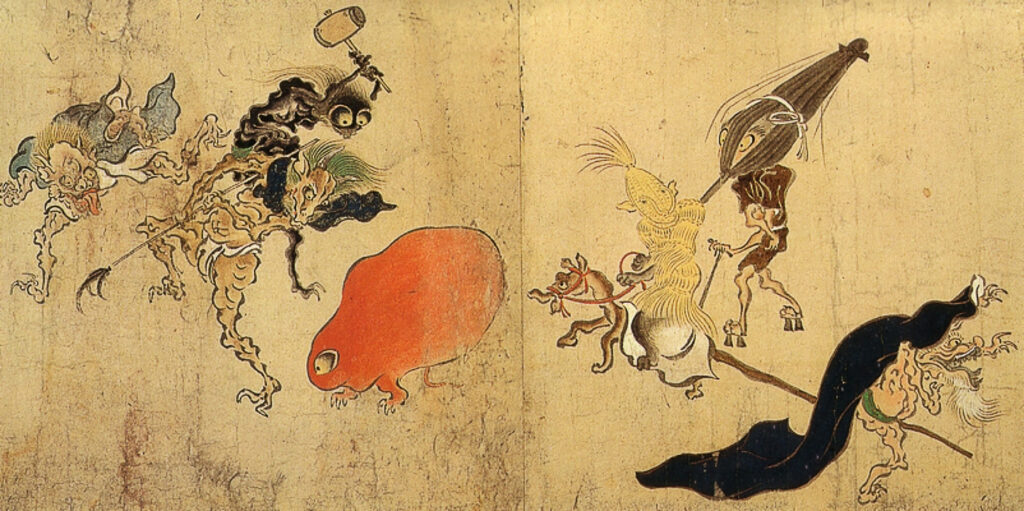
Originally, yokai and spirits were invisible energy in nature and mysterious phenomena, but as time went on, they came to be expressed visually. From the Kamakura period (1185-1333) onward, yokai began to appear one after another in concrete form in emakimono (picture scrolls) and otogi-zoshi (Japanese prose narratives written primarily in the Muromachi period (1392–1573)). While some emakimono were produced to tell the origin stories of temples and shrines, otogi-zoshi and other picture scrolls with high entertainment value also appeared, and yokai gradually became an object of entertainment. One of the most famous examples is the figure of a yokai, Tsukumogami, depicted in the “Picture Scroll of Tsukumogami” and “Picture Scroll of Hyakki Yagyo”. Tsukumogami is a term used to describe tools that have been used for a long time and are believed to be inhabited by kami and spirits, and to play tricks on people. It is believed that after 100 years, a tool can acquire a spirit and change into this. The word “Tsukumo” is said to be a reference to the word “99” (tsukumo) in the ” Picture Scroll of Tsukumogami”, which means “a long time (99 years)”. This belief that spirits, or energy, reside in vessels and objects is a very good example of how Japanese culture is rooted in animism. The characterization of invisible existence, and the abundance of variations on that characterization, is the element that makes Japanese subculture what it is today.

The elements of yokai depicted in entertainment through picture scrolls and performing arts (Noh and Joruri) were mainly those of court nobles, temples and shrines, but after the Muromachi and Sengoku periods, they spread from the samurai to the townspeople, and became culturally connected with the early Edo period. In the Edo period ( well, there are 300 years to summarize), with the development of printing and publishing technology yokai became even more prevalent in the culture and subculture of the common people. Yokai were also used in the designs of publications/toys for children, such as karuta, sugoroku, and *Tatebanko, and the yokai, which had originally been an object of awe, came to be seen as a familiar character to people. Yokai also came to be depicted as subjects in ukiyoe paintings. Ukiyoe is often thought of as high art because it influenced impressionist painters such as Claude Monet and spread “Japonisme” in Europe in the late 19th century, but it was originally used for paintings of beautiful women, actors, and famous places that reflected the customs of the time and were considered “bad places” by the shogunate. However, it was originally a subculture of the Edo period.
*Tatebanko : papercraft sculpture representing a scene akin to a painting.

My favorite Ukiyoe artists are Kuniyoshi Utagawa and Yoshitoshi Tsukioka. Kuniyoshi Utagawa (November 15, 1798 – April 14, 1861) was one of the most famous Ukiyo-e artists of the late Edo period. With his rich imagination, innovative designs, unconventional ideas, and precise drawing skills, he created many works with a wide range of appeal not limited to the framework of Ukiyoe.
Utagawa Kuniyoshi is famous for his samurai paintings, but he also painted many yokai. The famous “Furudairi of Soma” ( Princess Takiyasha Calling up a Monstrous Skeleton Specter at the Old Palace in Soma) depicts a scene in which a skeletal demon summoned by Princess Takiyasha, the orphaned child of Taira no Masakado, is about to attack Mitsukuni Oyataro. The original story (the reading “Utouyasukata Chuugiden” by Santo Kyoden) had many life-sized skeletons, but Utagawa Kuniyoshi depicted the scene as a single giant skeleton. In terms of yokai, this is the “Gashadokuro” (hungry skull). Gashadokuro was created in the middle of the Showa period (1926-1989) and became famous when it appeared in “Gegege no Kitaro” by Shigeru Mizuki. The skeletal monster is a common motif in all times and places .
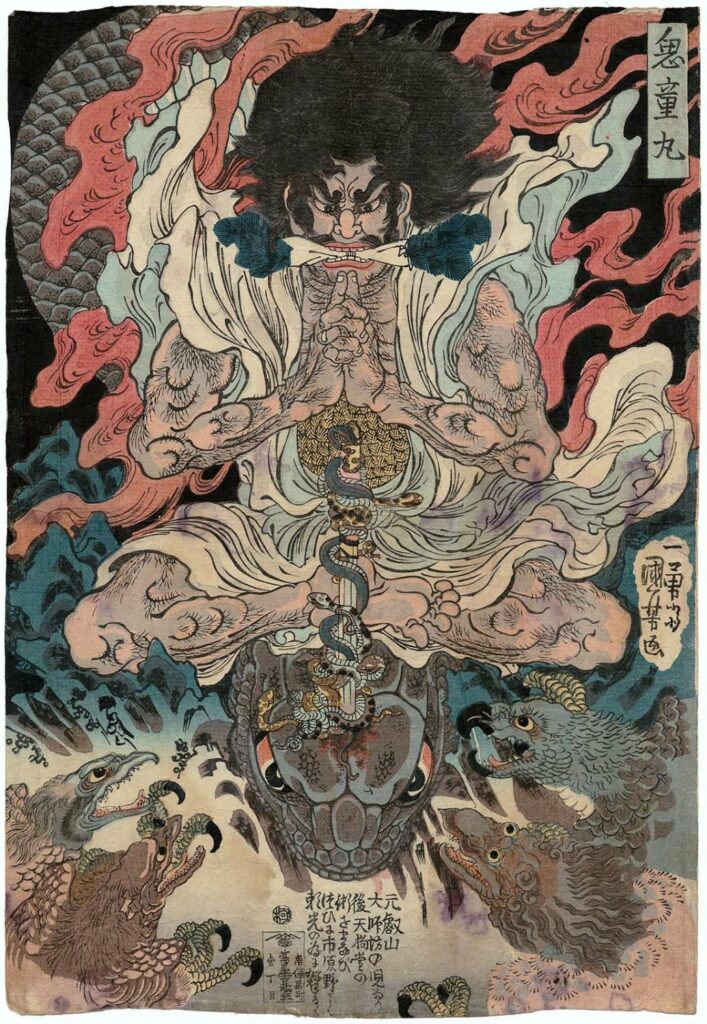
Kido-maru” , also by Kuniyoshi, is based on a yokai (a hybrid of human and demon that would make a good protagonist for the Weekly Shonen Jump manga) that is believed to be a child of the famous demon, Sahutendoji. Along with stylized flames, the figure of Kidomaru riding a giant snake comes at you with great power. Kuniyoshi’s works have great sketching skills, but the composition of the screen and the way he cuts out the movements of the characters are very stylized, which is similar to modern animation.
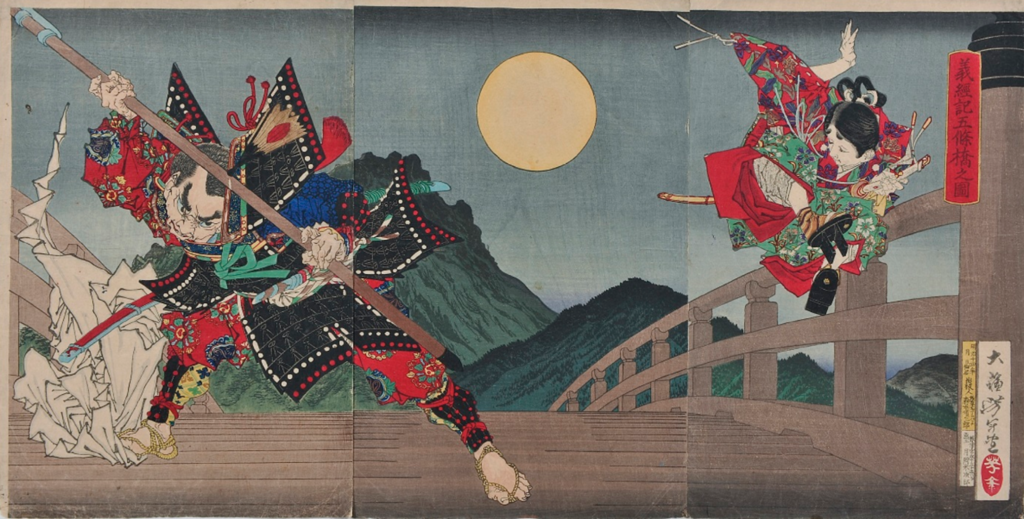
On the other hand, Yoshitoshi Tsukioka (April 30, 1839 – June 9, 1892) was an ukiyo-e artist active from the end of the Edo period to the middle of the Meiji period. He produced a wide variety of ukiyo-e works, including historical paintings, paintings of beautiful women, paintings of actors, genre paintings, classical paintings, and battle paintings, and showed a unique style in each field. His technique of stopping and showing the moment of movement as if it were stop-motion has something in common with manga and graphic novels, which have been developed since the Showa period, and he is regarded as a pioneer of graphic novels.(Above image)Like Kuniyoshi Utagawa, Yoshitoshi Tsukioka is also famous for his samurai paintings, but he has also painted many works with motifs of monsters and myths.

In “Susanoo-no-Mikoto Izumo no Hikawakami ni Yamatano orochi”, he depicts the conquest of Yamata-no-Orochi by Susanoo-no-Mikoto, an episode in the Book of Ancient Matters, with a unique and powerful touch.Yamata-no-orochi is the largest monster in Japanese mythology, or rather a monstrous beast. In this picture, it has only one head. The unique shape of the water splashes and the wrinkles on Susanoo-no-Mikoto’s clothes make this a unique ukiyoe. Yoshitoshi emphasized the importance of specters as the subject of his works throughout his life, and “Shinkei Sanjurokkaisen” is considered to be a compilation of his paintings of specters.
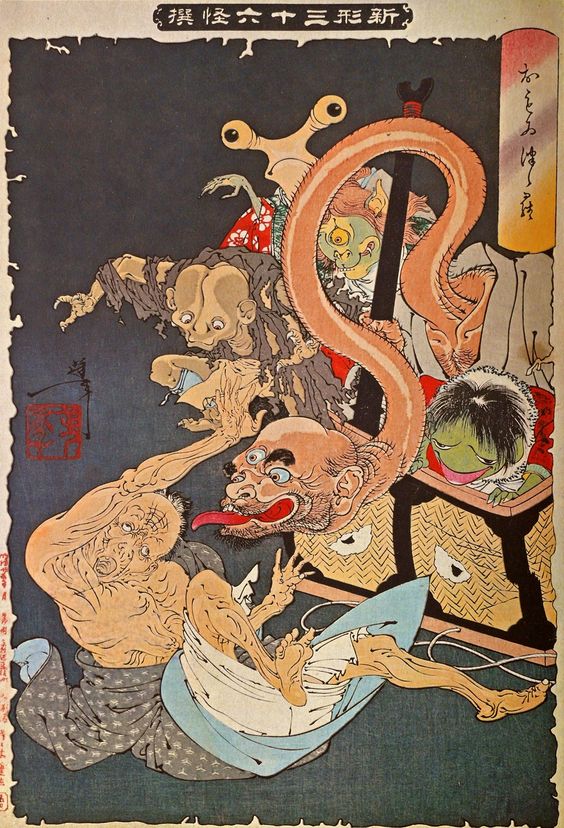



Although a little different from Kuniyoshi and Yoshitoshi, Toriyama Sekien (1712 – September 22, 1788) is the one who should not be overlooked when talking about yokai. Sekien studied painting as a student of the Kano style, a huge sect of Japanese painting, and published “Gazu Hyakki Yakou” (One Hundred Demon Nights) in 1776. Since the publication of this work, he has been known as a painter of yokai.He also published other works such as “Konjaku Gazu Zoku Hyakki”, “Konjaku Hyakki Shuui”, and “Hyakki Tsurezurebukuro”, which are sometimes collectively called “Gazu Hyakki Yakou”. Sekien’s paintings of yokai are characterized by a style that invites smiles and strangeness, which has been seen in yokai picture scrolls such as “Hyakki Yako ” and “Bakemono Zukushi” in red books, rather than the kind of paintings that unnecessarily stir up fear and a sense of cruelty that Katsushika Hokusai, Utagawa Toyokuni, and Utagawa Toyohiro depicted in their later works such as Go-kan and Yomi-hon.

In addition to the many yokai depicted in the well-known folklore of kappa, tengu, nekomata, raccoon dogs, and foxes, there are also many more niche yokai such as Tesso (Raigo Ajari) and Kuro-zuka (Onibaba of Adachi-ga-hara), as well as yokai depicted in earlier works such as “Kokin Hyakumonogatari Reputation” (1686) (Akaname, Tsurubebi, and Kamaitachi). (Akaname, Tsurubebi, Kamaitachi), and many other monsters that have been depicted in earlier works, making it a veritable encyclopedia of monsters. It is said that Sekien created his own yokai not only from legends and folklore, but also from the manners and customs of the time, satire of the situation, and jokes.The yokai Hatahiro is one of the Japanese yokai depicted in Sekien’s “Konjaku Hyakki Shuui” (The Hundred Demons of the Past and Present) and is a fabric yokai. The cloth is woven on a loom, and is transformed into a snake. According to the commentary in “Konjaku Hyakki Shuui” (The Hundred Demons of the Past and Present), when a woman weaves a cloth while holding a grudge against her husband who never returns home, the grudge gets trapped in the cloth she is weaving, and the cloth turns into a serpent and goes looking for him. According to one theory, it is said that Sekien created this monster by combining the words “jashin” (邪心 evil heart) and “jashin” (蛇身 snake’s body).
Sekien’s paintings of yokai have had a great influence on later generations of artists, and many of his works have become common visual images of yokai. The modern Japanese people’s image of yokai is largely based on Shigeru Mizuki’s work, but many of Mizuki’s paintings of yokai are also based on Sekien’s works. It can be said that the works of Toriyama Sekien have been passed down to the present day through Mizuki Shigeru. In this way, old spirits have become yokai, subcultures that have spread and survived through the ages until the present day.
Although I said I would talk about Shigeru Mizuki, I did not get to the present day again. I will continue this in the next article.
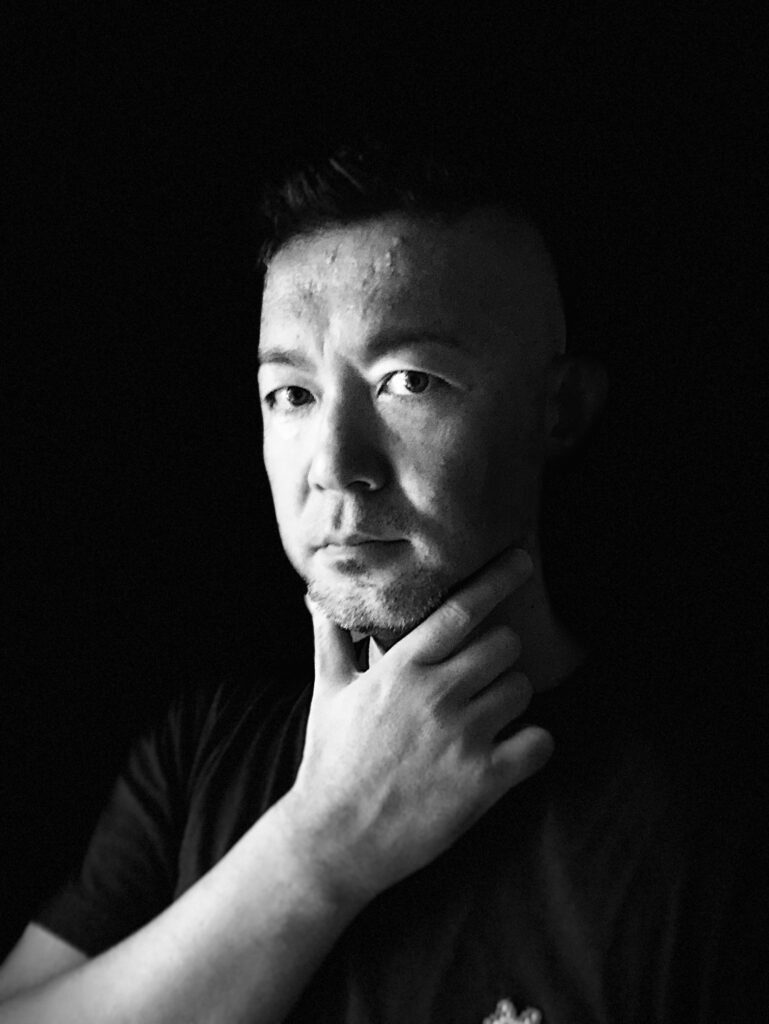
Taketo KOBAYASHI
Post-digital artist
ARTSTATION
Taketo Kobayashi (artstation.com)
Instagram ID
@humanoise
After having experience of 3D graphics and animation at Tokyo Institute of Technology creative laboratory, and Gonzo Co., Ltd., Taketo started his own project as an artist. Using digital technology like CG, 3D printing as his “brush”, Taketo creates a wide variety of artworks from 3D printed sculpture to animation. In a collaboration project XSENSE, Taketo utilizes CGI in street art to create murals(Denver, CO, USA), also using his unique style animation for stage design and collaborated with contemporary Noh theatrical group. In addition to creating his own artworks, Taketo curates the group art show “ARTs of JOMON” hosted by Japanese non-profit JOMONISM, keep introducing contemporary artists/artworks influenced by ancient Japanese Jomon culture.(Aomori Museum of Art / Spiral Garden / Denver International Airport / Kuala Lumpur)
It is Taketo’s mission to make invisible things, emotions, energy, next dimensions of consciousness into “shapes”.
Project/Art history(excerpt)
PROJECTS Digital G-O-D, UltraSuperNew gallery, Singapore, Jan 2020
Haw Par Villa RE•MIX
Chinese Cultural Centre, Singapore , Jan 2020
”Light to Night Festival” Projection mapping at Asian Civilization Museum, Singapore , Jan 2020
A SIGN OF THE TIMES EXHIBITION, Singapore , Jan 2019
”ARTs of JOMON” exhibit @ISETAN KL, Malaysia , Aug 2017, curation&direction
“Colorado Crush”, a mural festival in Denver, CO. Sept 2016, created artwork
“DMS” Collaboration with Canon June 2015, created&exhibited 3D printed prosthetic leg
”Oakley Exhibition” Exhibited artworks at Oakley store Harajuku, Tokyo, Oct 2014
AWARDS “Eisen Herz” Ufab Global Creative award Finalist. 2016. 3D printed cover for “Tamiya mini 4WD” using generative design
“More Than Human type-Unicorn” a 3D printed prosthetic leg. Ufab Global Creative award Finalist. 2015
“SC1-EXP” Zushi International Projection Mapping Competition, Grand Prix. 2014
“Yakushi-Nyorai”(2013)
3DCG model for 3D printing. Winning work at Digital modeling competition held by Japan Society for Graphic Science
Original CG animation ‘Matsuri’(May 2010)
Design, modeling, production coordination. A CG animation based on Japanese ‘Jomon’ culture. Created for promotion of Aomori Prefecture. Accepted at Siggraph Asia 2010. (On VIMEO: https://vimeo.com/25144961)
Photo References
■A part of “Picture Scroll of Hyakki Yagyo”.
https://ja.wikipedia.org/wiki/%E7%99%BE%E9%AC%BC%E5%A4%9C%E8%A1%8C%E7%B5%B5%E5%B7%BB#/media/%E3%83%95%E3%82%A1%E3%82%A4%E3%83%AB:Hyakki-Yagyo-Emaki_Tsukumogami_1.jpg
■ Sugoroku of Yokai in the Edo Period
https://www.kumon-ukiyoe.jp/index.php?main_page=product_info&cPath=3_14&products_id=858
■ Princess Takiyasha Calling up a Monstrous Skeleton Specter at the Old Palace in Soma
https://mag.japaaan.com/archives/15739
■ Kido-maru
https://ja.wikipedia.org/wiki/%E9%AC%BC%E7%AB%A5%E4%B8%B8#/media/%E3%83%95%E3%82%A1%E3%82%A4%E3%83%AB:Kuniyoshi_Kidomaru.jpg
■ Yoshitoshi Tsukioka
https://www.neribun.or.jp/event/detail_m.cgi?id=201805131526201032
■ “Susanoo-no-Mikoto Izumo no Hikawakami ni Yamatano orochi”
https://mag.japaaan.com/archives/82737/2
■ “Shinkei Sanjurokkaisen”
https://www.pinterest.jp/pin/454089574902907095/
■ ‘Gamo Sadahide’s servant, Toki Motosada, hurling a demon king to the ground at Mount Inoha’
https://twitter.com/curiousordinary/status/1300214447324016641/photo/1
■ Yamawaro
https://ja.wikipedia.org/wiki/%E7%94%BB%E5%9B%B3%E7%99%BE%E9%AC%BC%E5%A4%9C%E8%A1%8C#/media/%E3%83%95%E3%82%A1%E3%82%A4%E3%83%AB:SekienYamawarawa.jpg
■ Nuppefuhofu
https://ja.wikipedia.org/wiki/%E7%94%BB%E5%9B%B3%E7%99%BE%E9%AC%BC%E5%A4%9C%E8%A1%8C#/media/%E3%83%95%E3%82%A1%E3%82%A4%E3%83%AB:SekienNuppeppo.jpg
■ Hatahiro
https://ja.wikipedia.org/wiki/%E6%A9%9F%E5%B0%8B#/media/%E3%83%95%E3%82%A1%E3%82%A4%E3%83%AB:SekienHatahiro.jpg